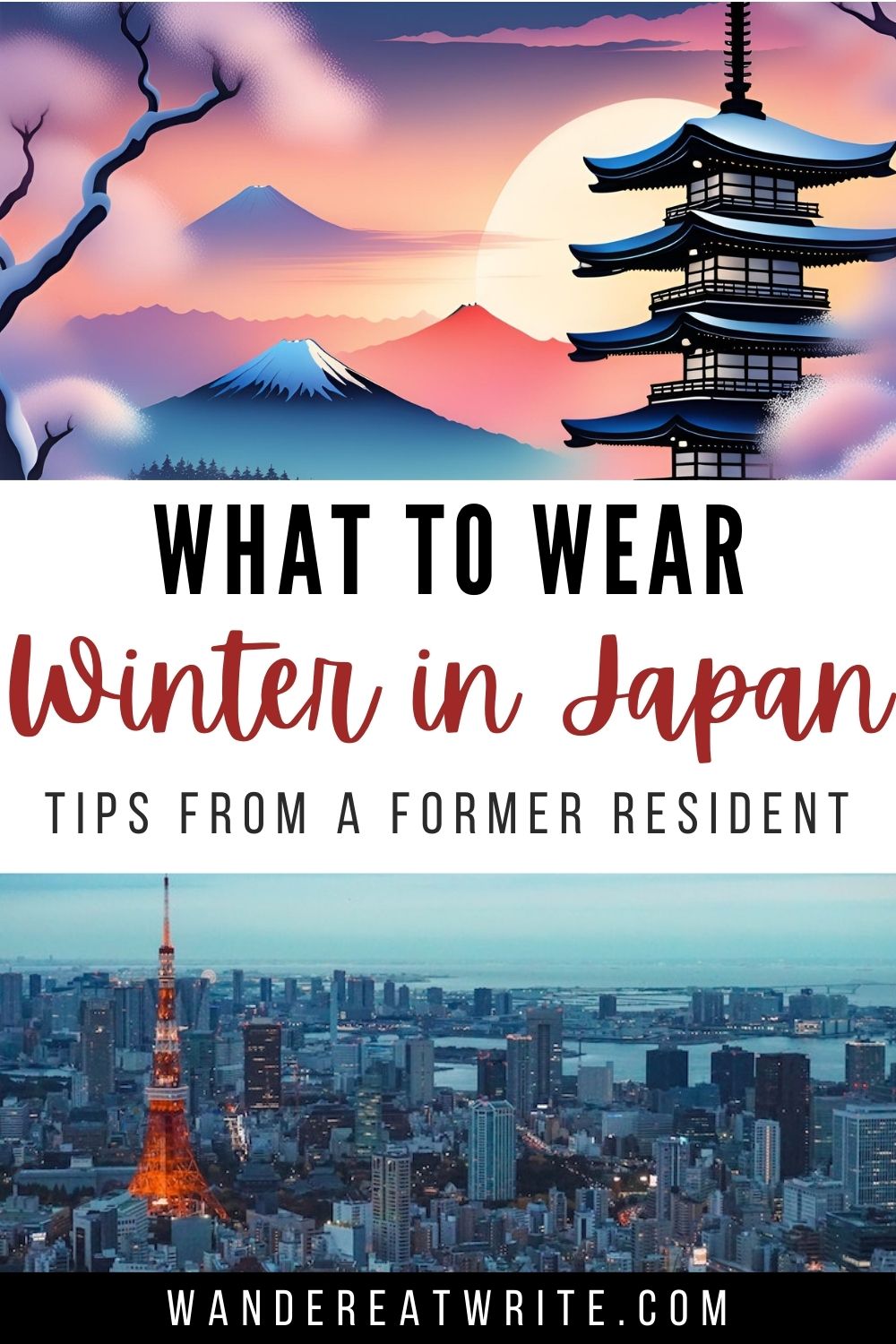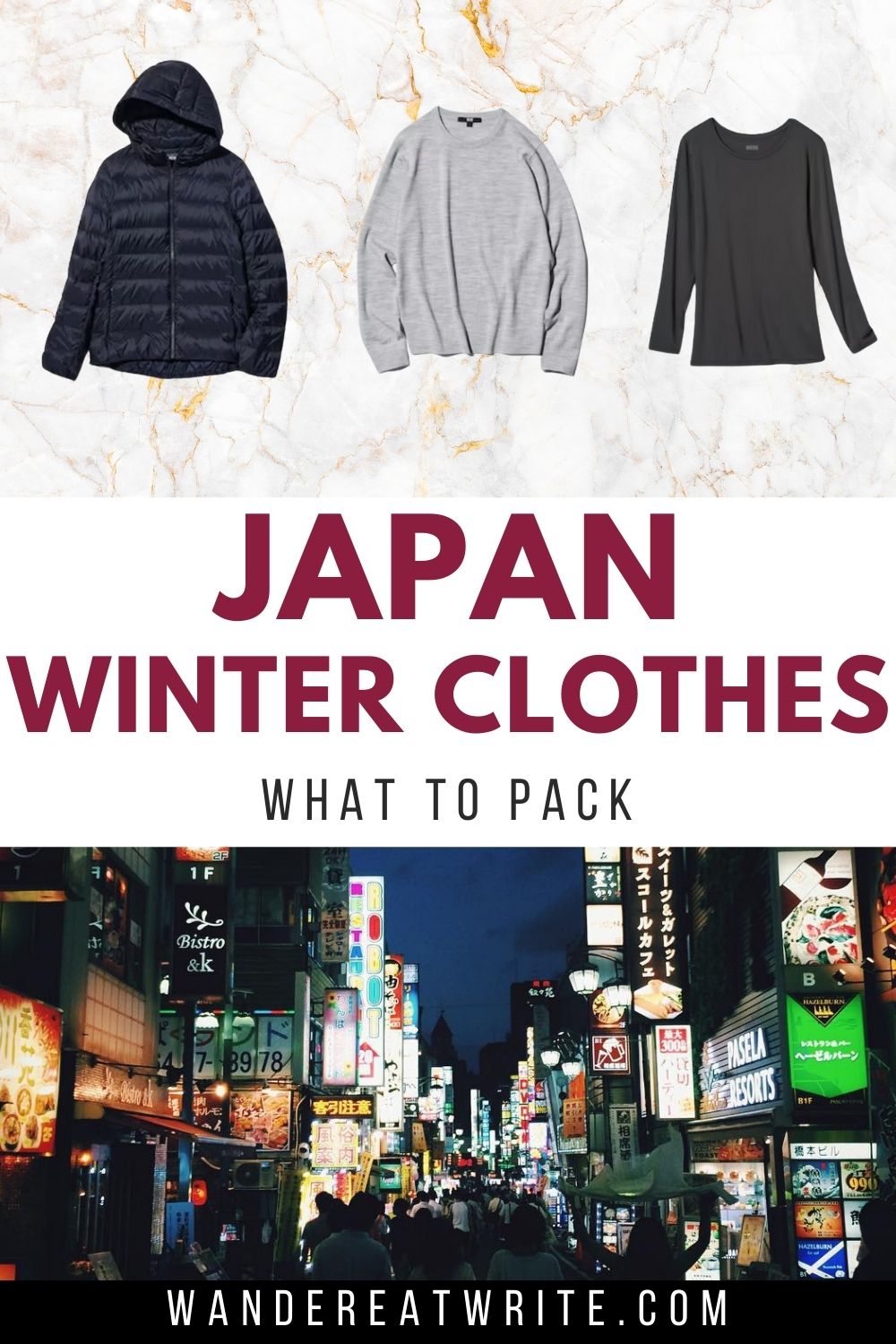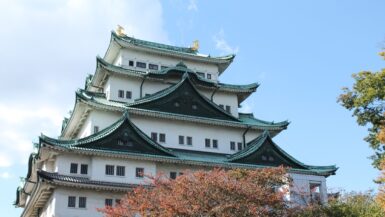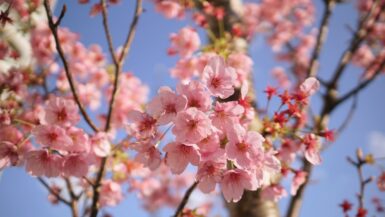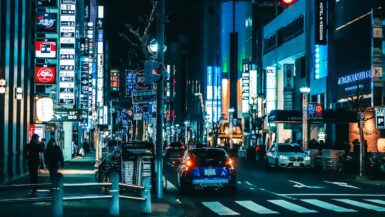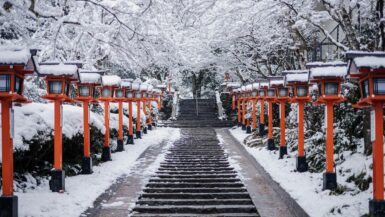
Not sure what Japan winter clothes you need for your upcoming trip?
This former resident is here to help!
Whether you’re looking to blend in with what people wear in Japan in winter or you’re wondering what clothes to pack for winter in Tokyo, I’ve got all the answers for you in this post.
I had a lot of similar questions before I moved to Japan, but after living there for a few years, I’m always helping out friends– and now, you!– with tips to ensure they’re well prepared before their trips to Japan.
Short on time?
For Japan’s winters, layering is key. Opt for layers that can be easily removed indoors or on trains in mild winter cities like Tokyo, Kyoto, and Osaka. Check out my Amazon Storefront for my curated list of winter clothing for Japan.
Travel Resources
✈️ Find the best flight deals with Kiwi.com
📶 Get this eSIM for internet access as soon as you land in Japan💳 My favorite credit card with no international transaction fees
🇯🇵 Download Google Translate to help you around Japan
🧥 Prefer to shop on Amazon? Here’s my winter clothing list for Japan
How Cold is Japan in Winter?
If you’re wondering “How cold is Japan in the winter?” the answer is it depends on where you’ll be visiting.
Japan experiences a wide range of winter temperatures due to its diverse geography.
In typical northern hemisphere fashion, temperatures decrease as you travel further north.
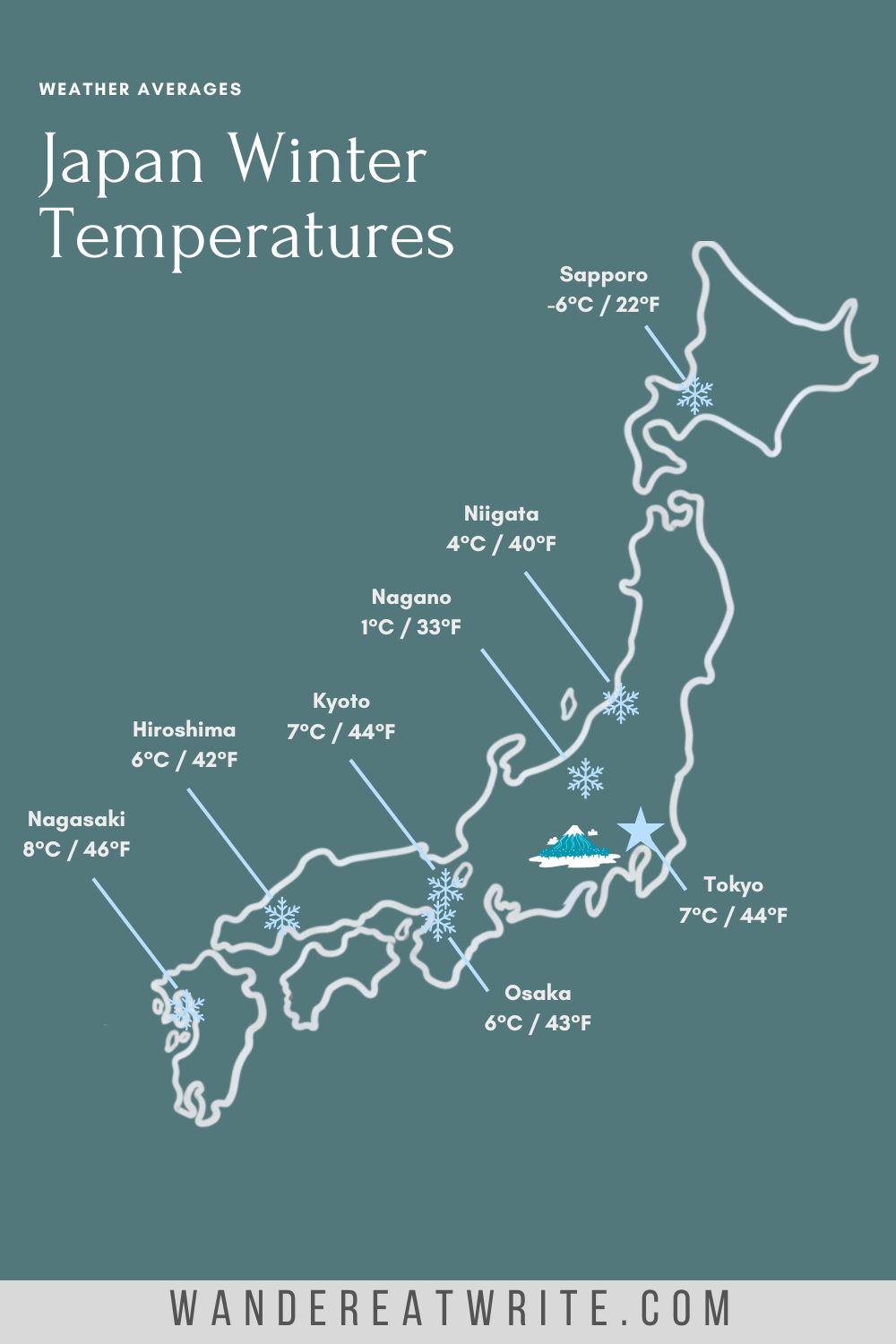
Hokkaido, Japan’s northern most island and where the city of Sapporo is located, sees winter temperatures averages as low as 9°F (-13°C) and as high as 26°F (-3°C).
Areas at higher altitudes and in the mountains, like popular winter sport cities Niigata and Nagano, will be slightly less cold with temperatures between 23°F-45°F (-5°C – 7°C)
Major Japanese tourist cities Tokyo, Kyoto, Osaka, and Hiroshima have milder winters, with temperatures ranging from 30°F to 50°F (around -1°C to 10°C).
For those wondering does it snow in Tokyo– it does occasionally, but usually just a light dusting for a few days.
It snows in Kyoto more than in Tokyo, however, due to its location in a basin surrounded by mountains.
While January is also typically the coldest month in all of Japan, winter temperatures can fluctuate and even extend past the season.
For example, it can still be chilly through early spring when people visit Japan during cherry blossom season.
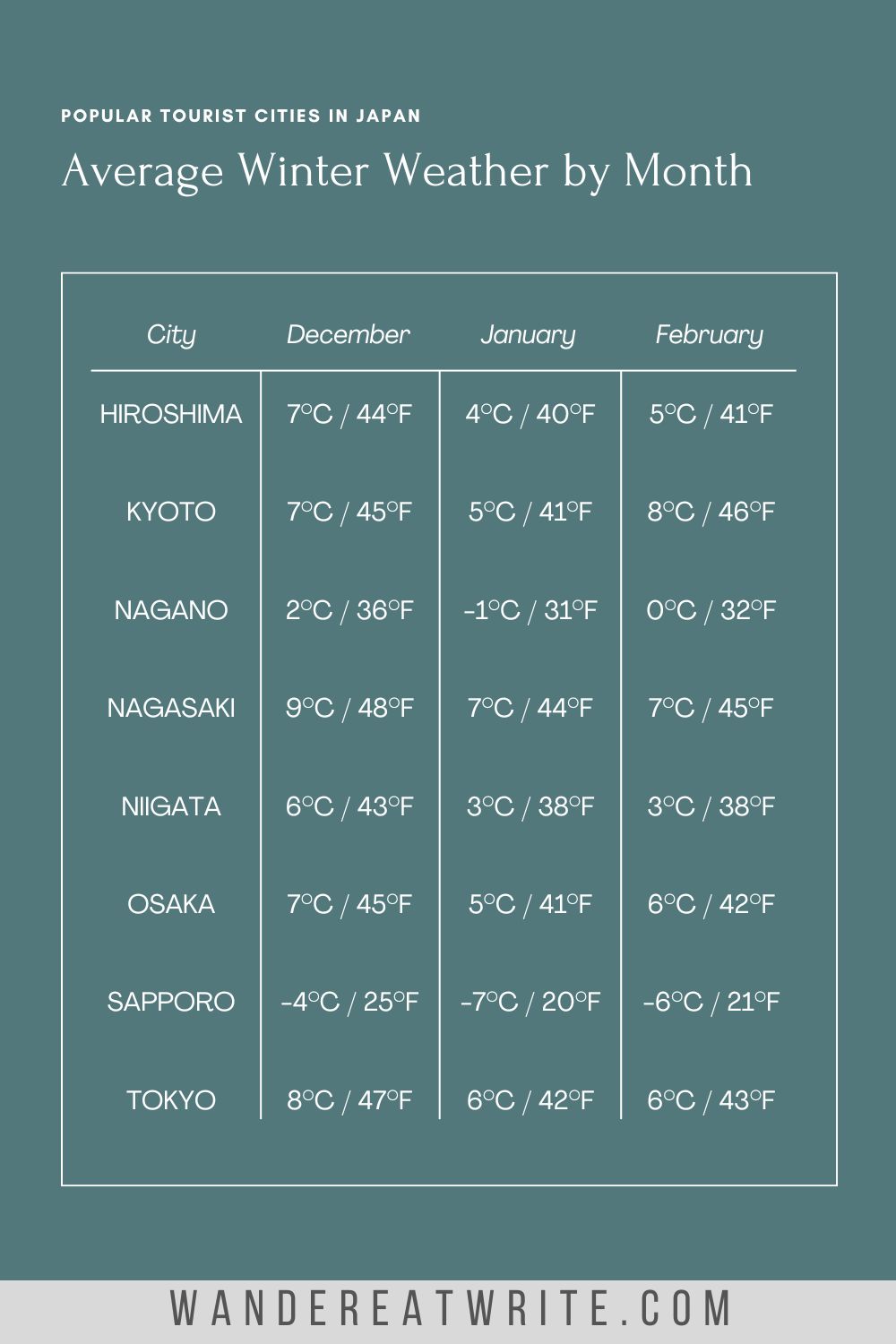
Japan Winter Clothes
Layering is the main thing to remember when packing for Japan and winter clothes.
This will ensure that you stay warm when needed, but that you are prepared for temperature changes as well when using public transport or doing a mix of outdoor/indoor activities.
What do People Wear in Japan in Winter?
Dressing like the locals isn’t just to blend in aesthetically when traveling– usually it’s practical, too.
In different countries, regions, or cities, people often dress alike for a reason.
Given the influence of seasons and weather on clothing choices, observing the wardrobe trends of locals can guide visitors in dressing appropriately for the climate.
So what do people wear in Japan in the winter?
In cities, the winter style tends to be smart but relaxed casual, with warm or dark colors and fabrics.
Women’s clothing leans toward a more loose silhouette with dresses and skirts more common than trousers.
For both men and women, they’ll typically wear 3+ layers:
- Base Layer: HEATTECH or thermal top; fleece tights or leggings bottoms
- Mid Layer: T-shirt, long sleeved, or sweater for tops; regular pants or fleece-lined trousers for bottoms as well as skirts/dresses
- Outer Layer: Down parka/puffer or wool pea coat
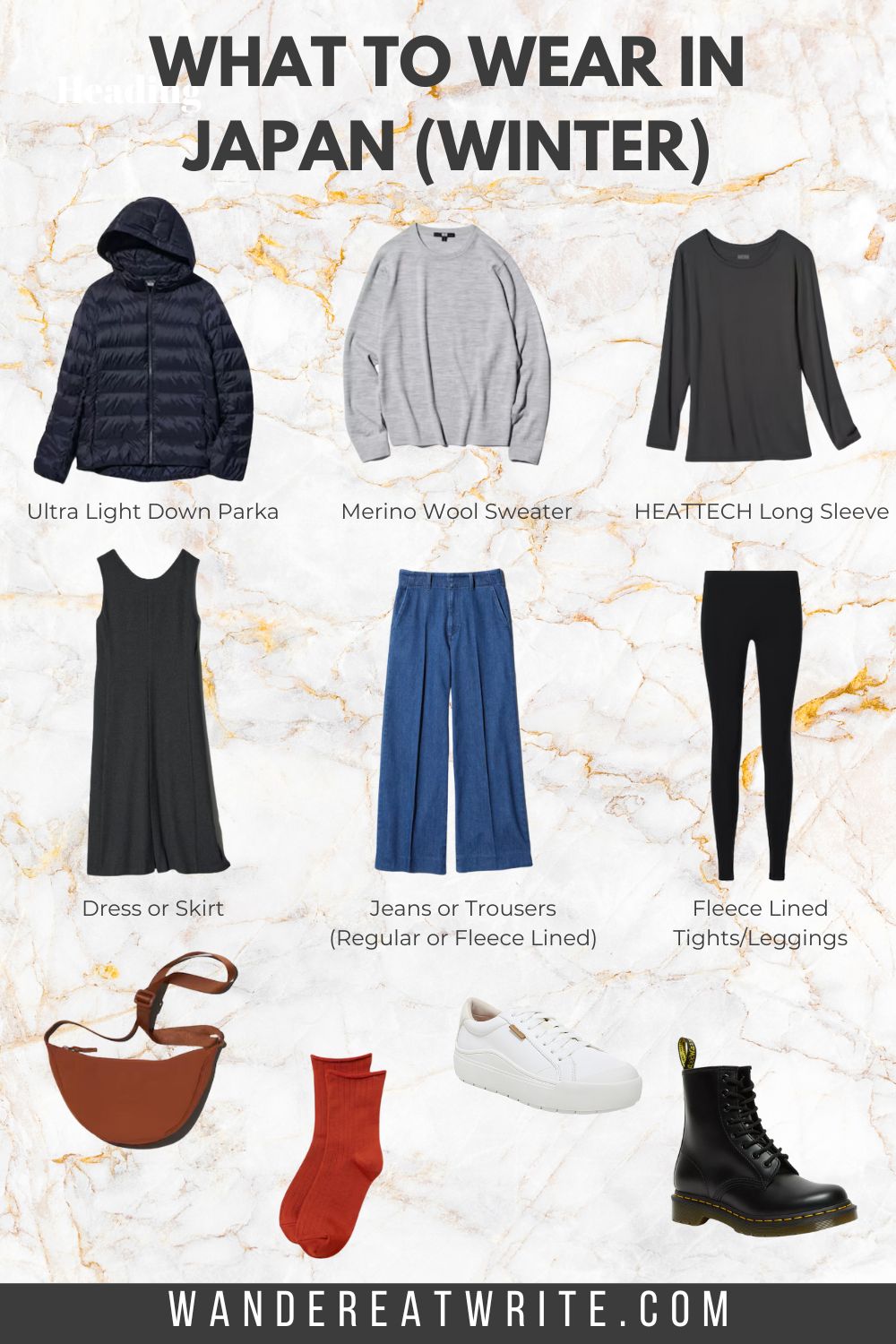
What to Wear in Winter in Japan
What to wear in winter in Japan largely depends on two factors: where you will be visiting and what activities you plan on doing.
If you plan on doing a lot of outdoor activities, winter sports, or you’re spending time in a northern city, you’ll definitely need to dress for freezing temperatures.
Note that Japan’s humid weather also makes it feel colder in low temperatures, amplifying the chill more than regions with dryer climates.
So while the day’s forecast might be above freezing, it could feel lower.
For what to wear in Tokyo and other major central cities when city exploring, remember that you’ll be moving around a lot as well as using public transport and spending time indoors.
Trains can get stuffy and cafes, malls, and museums will all be heated.
You definitely want to wear layers that are easy to take off and put on as needed.
Plus, this gives you more options for different outfits to wear in pics and posts with Japan captions!
Here’s my guide to the best way to layer clothes in Japan for winter:
Outer Layer
My Favorites
Ultra Light Down Parka: Men | Women
Hybrid Down Coat: Men | Women
Most people in Japan either wear some type of down jacket/parka or wool pea coat.
The most popular type of jacket you’ll see both locals in Japan wearing as well as Asians abroad (like me in San Francisco) is the Uniqlo packable down parka.
It’s super lightweight and rolls up into its own little bag making it easy to pack for trips.
While it doesn’t look like it, it’s warm enough for cold days alone or you could wear it over a fleece jacket like I did when working in Antarctica for extra warmth.
That being said, you probably don’t need more than one outer layer if you’re sticking to the main cities like Tokyo, Osaka, and Kyoto.
However, if you’re planning on visiting Hokkaido or doing some snow sports in Niigata or Nagano, you may want to consider a heavier parka or a ski jacket designed for the activity.
Mid Layer
My Favorites
Merino Sweater: Men | Women
If you run on the colder side, a sweater made from merino wool or cashmere will keep you warm while also being lightweight to pack.
Minimalist packers like me won’t want to pack all sweaters though for this winter Japan trip; one will suffice and two will be plenty.
Besides a good sweater, my go to when living in Japan was a flannel button down.
This gave me more options than a sweater, especially when traveling, as I could easily wear it open if it was too warm.
Base Layer- Tops
My Favorites
HEATTECH Long Sleeve: Men | Women
For inner base layers, be sure to pack two kinds: a thermal undershirt and a regular t-shirt.
You’ll need some type of long-sleeved under shirt especially when traveling to the colder parts of Japan.
These heat tech shirts from Uniqlo are a winter staple among Japanese people because of how lightweight yet warm they are.
They’re easy to layer a shirt or sweater on top of without adding bulk, making them so comfortable to wear.
For those sticking to Tokyo and other milder climate cities, you might not need a full sleeved thermal layer, but you may still want a t-shirt to wear under a button down or sweater.
There may be days where a t-shirt and jacket are all you need as well, so having a few regular tees will be handy.
Base Layer- Bottoms
My Favorites
HEATTECH Ultra Warm Leggings: Men | Women
Fleece-Lined Pants: Men | Women
Thermal bottoms will only be needed in colder areas in Japan for the most part.
Around Tokyo, Osaka, and Kyoto, it’s probably be too warm to wear thermal pants/underwear under jeans.
But if you know you run cold, a good pair of thermal underwear will pack down small so it might be worth to pack.
Women, on the other hand, wear inner layer bottoms more frequently in the winter, albeit under dresses or skirts.
The most common inner layer bottoms for women are fleece-lined tights or brushed leggings.
As mentioned previously, if you’re headed to Hokkaido for the winter festivals or planning on heading up to the mountains for winter sports, inner layers for everyone will be crucial.
Either plan on bringing thermal underwear or bring a pair or two of fleece-lined pants (along with appropriate snow pants for skiing/snowboarding).

Socks
My Favorites
HEATTECH Pile Lined Socks: Men
HEATTECH Crew Top Roll Socks: Women
Tokyo visitors will be fine in regular crew socks.
Nothing too heavy as you’ll probably be doing a lot of walking and hanging out indoors most of the time.
My go to when traveling with carry-on only are merino wool socks as they are both warm and lightweight, but also odor-resistant so I can get more wears out of them before needing to wash them.
Outside of city exploring you’ll want to bring some thicker or heavier weight wool socks for extra warmth if you’re planning on doing a lot of outdoor activities.
Also keep in mind that for many tourist places such as temples and even some traditional restaurants, you’ll be required to take off your shoes.
So make sure your socks look decent and don’t have any holes in them!
Shoes
My Favorites
Allbirds Wool Runners: Men | Women
Dr. Scholl’s Time Off Sneakers: Men | Women
Dr. Martens 1460 Unisex Boot
Comfort is key when city exploring in Japan as you’ll be putting in quite a few miles on your feet each day.
A pair you already have broken in will be a safer bet than purchasing new shoes just for this trip that haven’t had time to break in.
My favorite walking shoes that also look stylish and travel well are the Dr. Scholl’s Time Off sneakers or Allbirds Woolrunners.
While warmth is of course important, you also don’t want to overheat while sitting on a stuffy train.
You can always take off a jacket when out and about but you can’t really do the same for your shoes!
If you’re worried about your sneakers not being warm enough or waterproof, a pair of boots can also be useful.
When I lived in Japan, I had boots similar to Doc Martens that I’d wear to stay a little warmer and to also protect against any light rain that might occur while wandering around town.
Scarves
Scarves aren’t necessary, but you’ll see a lot of Japanese people wear them.
They’re nice to have but you can always purchase one when you get to Japan if you don’t initially pack one with you.
It’ll also make for a nice souvenir to bring home and remember your time abroad.
Hats and Earmuffs
I never felt the need to wear a beanie or any other head coverings while living in Japan, but then again I do have a lot of hair.
Earmuffs also aren’t really a thing to me in the U.S., but you’ll see a fair amount of women in Japan wearing a pair.
As with everything else, you probably don’t need a beanie if you’re just bouncing between the three main central cities in Japan.
But if you’re headed to colder areas, either plan on packing one or buying one once you get to Japan.
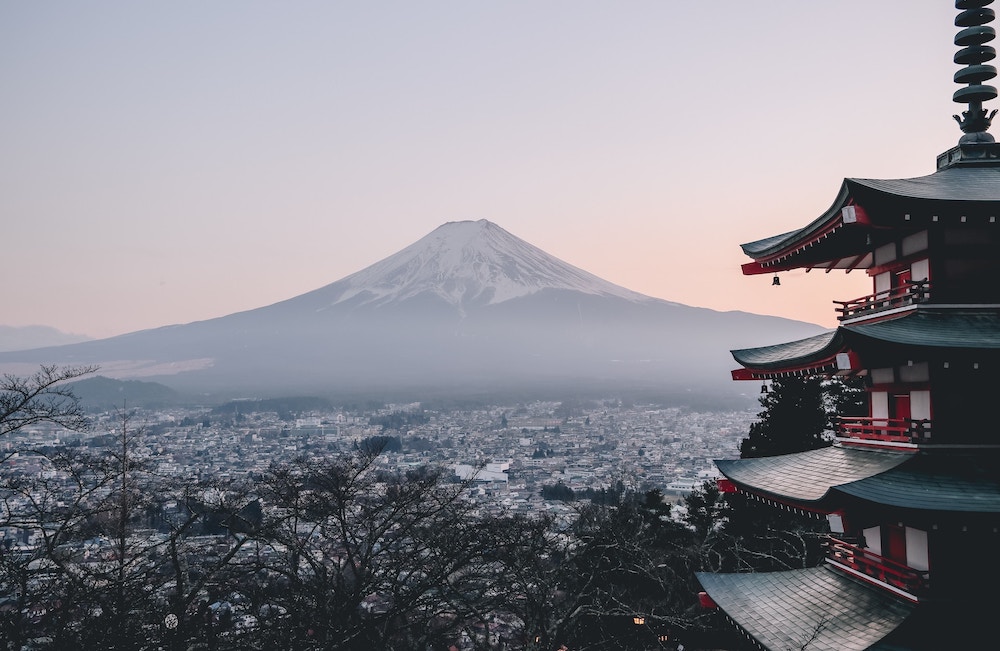
Where to Buy Winter Clothes in Japan
If you’re looking for where to buy winter clothes in Japan, these are some of the most popular stores locals shop at that also offer affordable prices.
Uniqlo
Pretty much the holy grail of budget basics, athleisure, and work wear.
They offer clothing in cotton, merino wool, cashmere, and technical fabrics.
Uniqlo is also available internationally, including the US, although there will be a much larger selection in Japan.
GU
This is Uniqlo’s sister store that offers similar but more basic styles (in my opinion) and at a lower price point.
I still wear a few items I bought at GU 10+ years ago, which is also a plus!
Muji
Similar to Uniqlo, this store sells good quality clothing at a budget price point.
Styles offered are minimalist and loose-fitting, which is in line with Japanese fashion.
Parco
Parco is a large multi-level department store you’ll see in the cities that not only include food but will also have everything from stationery to electronics as well as a restaurant or cafe.
The clothing styles and prices may be hit or miss, but if you can’t find winter clothes elsewhere for you, Parco is still a decent place to look.
Western Clothing Stores
If Asian clothing styles or sizes don’t work for you, there are western stores you can shop at in a pinch as long as you’re in one of the larger cities.
This includes familiar brands like H&M and Old Navy.
Japan Packing Essentials
After you’ve got all your winter clothes for Japan covered, don’t forget these other Japan packing essentials:
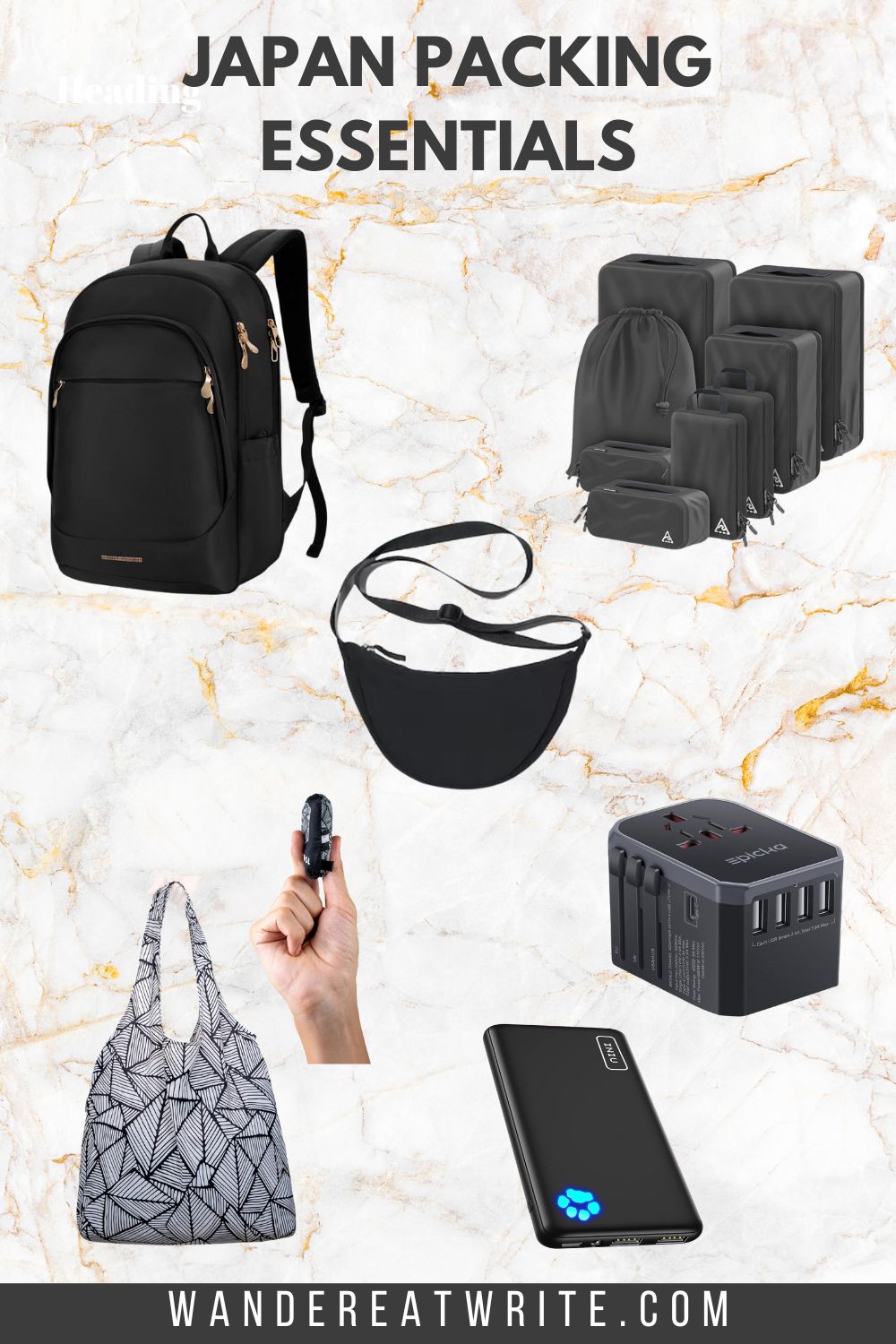
➡️ Power Bank: Useful for when you’re out exploring all day.
You’ll be using your phone for everything from train schedules and translation in addition to taking photos and videos– make sure you can recharge it while on the go.
➡️ Travel Adapter: Make sure you can charge your electronics in Japan.
➡️ Day Bag: Whether your go to is a backpack or sling bag, having a bag that’s small and lightweight, and easy to carry around all day is a must when traveling around Japan.
➡️ eSIM: Ensure that you always have internet to help with translation and directions.
An eSIM gives you internet the minute you land so that you don’t have to worry about purchasing a physical Sim card.
➡️ Packing Cubes: My top tip for keeping luggage organized.
Bonus if they’re compression cubes also, so that things pack down even more– leaving extra room for souvenirs!
Things to Do in Japan in Winter
While most people tend to visit Japan during cherry blossom season or in warmer months, there’s still lots of things to do in Japan in the winter!
Visit the Winter Festivals
Japan has four distinct seasons which locals not only embrace but celebrate.
Winter festivals are common in most Japanese cities and definitely worth checking out.
These events usually include entertainment, music, and street food.
The further north you go, you’ll bound to find festivals with snow or ice sculptures as well.
Check Out Winter Illuminations
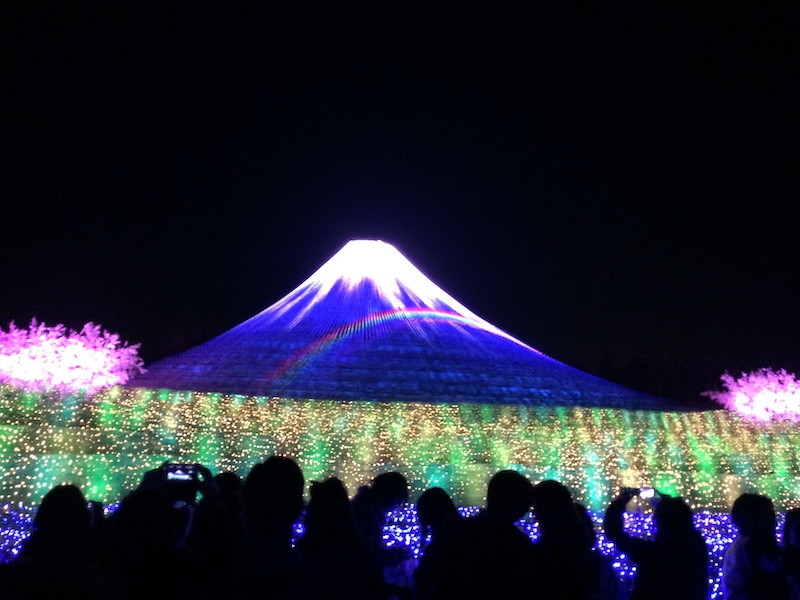
One of the main parts of winter festivals usually involve winter illuminations.
You’ll see elaborate illumination set ups from winter motifs and light tunnels to a mini Mt.Fuji lit up.
If you love winter wonderlands like me, then visiting Japan in the winter is definitely for you!
The illuminations can be seen all around the city– not just at festivals.
Especially in Tokyo, you can easily run into a street that has it’s trees or lampposts lined with lights.
It makes for the perfect evening stroll.
Relax in an Onsen
Have you really been to Japan if you don’t experience an onsen?
Onsen are natural hot springs in Japan that can be both traditional bathhouses as well as full on theme parks.
Whether you prefer to relax in a zen indoor onsen or outdoors, the warm dip will be sure to keep you toasty during the winter temperatures as well as relaxed between your Japan adventures.
Ski and Snowboard
If you’re an outdoor enthusiast, skiing or snowboarding in Japan’s finest slopes is for you.
Head to Nagano, home of the 1998 Winter Olympics, or Niigata for some fun in the snow.
Try Seasonal Dishes
Keeping in theme with celebrating the seasons, Japan also loves its seasonal cuisine.
After all, some dishes are just better enjoyed when it’s cold out!
This includes warm, popular Japanese foods like oden or shabu shabu.

Best Cities to Visit in Japan in Winter
No matter what activities you prefer when traveling, there’s a place for you to visit in Japan in the winter!
🏂 Snow Sports: Nagano and Niigata
☃️ Snow Festivals: Sapporo and Hakodate
🗼 City Exploring: Tokyo, Kyoto, and Osaka
☀️ Warmer Weather: Miyazaki, Kagoshima, and Okinawa
What to Eat in Japan in Winter
As I mentioned earlier, some of the most popular Japanese foods to eat in the winter are warm dishes.
Make sure you try these out:
- Sukiyaki: Sweet and savory hot pot with beef, vegetables, and tofu
- Shabu Shabu: Savory hot pot with lighter flavors than sukiyaki
- Oden: Winter fish cake stew, also the origin of this emoji 🍢
- Nikujaga: Meat and potato stew
FAQ: Japan Winter Packing List
Do I need gloves for Japan winter?
This will depend on where you’re going.
When I lived in central Japan, I never felt the need to wear gloves.
I’d simply keep my hands in my pockets when walking outside.
But if you’re going to the colder areas of Japan, warm gloves will be a necessity.
Do I need a puffer for Japan?
Most likely, yes, if you want to be warm and comfortable in Japan during the winter, a puffer jacket will be essential.
However, you can substitute this with any kind of mild winter coat you have.
Can you wear leggings as pants in Japan?
Can you? Yes.
Do locals? Not really.
Japanese people do wear leggings, but usually not on their own.
Most Japanese people who wear leggings either do so only when working out (and even then they might wear shorts over them), or under skirts and dresses.
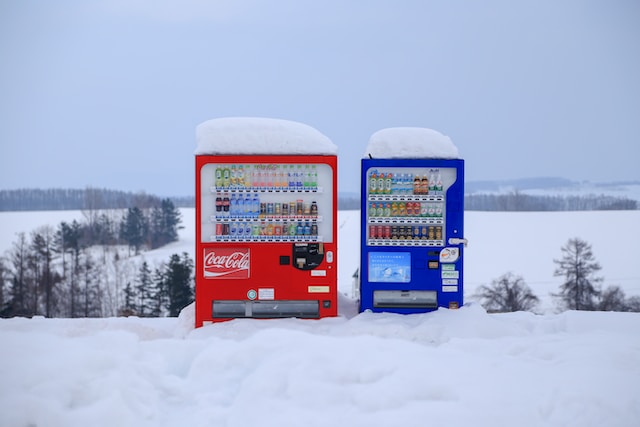
How Do I Pack for 2 Weeks in Japan in Winter?
For a typical 2 week winter Japan trip to Tokyo, Kyoto, and Osaka, here’s what I would pack:
- 1x Jacket : Light down parka or pea coat
- 2-3x Mid layers: Sweaters or button downs
- 2-3x Long sleeved inner layers: Thermal HEATTECH or long sleeved shirts
- 1-2x Short sleeved inner layers: T-shirts
- 1-2x Bottom inner layers: Thermal underwear, tights, or leggings
- 2-4x Bottoms: Jeans, skirts, or trousers
- 3-7x Pairs of socks
- 1x Pair of comfortable walking shoes
- 1x Pair of waterproof shoes/boots (optional)
- 1x Beanie (optional)
- 1x Gloves (optional)
- 1x Scarf (optional)
Note that this is all dependent on how active you’ll be, if or how often you plan on doing laundry, and your natural body chemistry.
This list is how I would pack; but I like to travel and even cruise with carry-on only and do sink laundry every couple of days.
I also don’t tend to sweat or have much body odor.
If body odor clinging to clothing is something you’re worried about, look into clothes made from merino wool like Unbound Merino.
Final Thoughts: What to Wear in Winter in Japan
Packing for Japan in winter doesn’t have to complicated!
Just remember your layers and if all else fails– know that there are plenty of amazing stores in Japan where you can pick up extra clothing along the way if needed.
But most importantly, enjoy your bucket list trip to Japan!
Read more:
- Does it Snow in Tokyo? When & What to Expect in Winter
- Does It Snow in Kyoto? When & What to Expect in Winter
- Top 50 Most Popular Japanese Food to Try in Japan
- Is It Worth Going to Japan in Cherry Blossom Season? Tips from a Local
- Does Japan Celebrate Valentine’s Day? Answers from a Local
- How I Got Paid to Live in Japan: My Experience Teaching ESL in Japan
- 250+ Best Japan Captions for Instagram
Pin and Save
